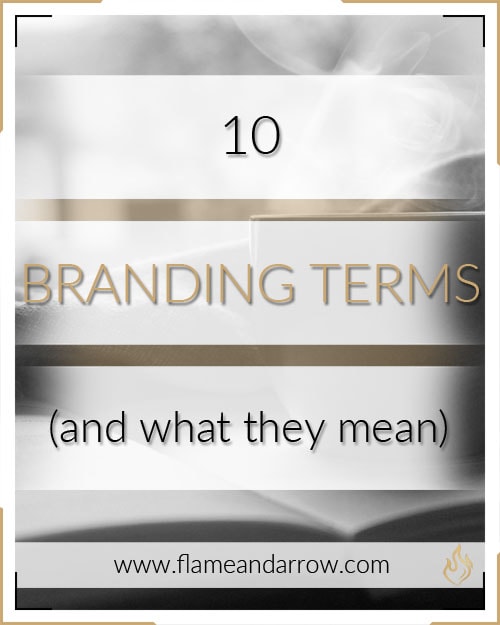10 Branding Terms (and what they mean)

By now you probably know that your brand is a crucial aspect of your business. After all, it’s how you’re perceived by the outside world. You know that branding is important.
You’ve probably heard a ton of phrases revolving branding thrown around everywhere. Oftentimes terms are lumped together and used interchangeably. However, while each part of the branding puzzle works together and each plays an important part, they are not synonymous.
There are a lot of misperceptions when it comes to breaking down and defining your brand. So today we’ll dive in and try to help clear up the confusion with 10 common branding terms and what they actually mean. What are they, and what makes them different?
We’ll break it down below.
Brand
Your brand represents your company to your audience, clients and the world. Contrary to what some people think, it is important to note that your brand is not just your logo. A logo is an important element, yes, but your brand is so much more. Your brand is a combination of your values, mission, design and strategy that come together to convey what your business is all about to your audience and shape their perception. Your brand is how someone perceives your business.
A successful brand is consistent in communication and experience. As a brand is about perception and experience; it is not a tangible thing. You can think of your brand as the image or idea your audience has when thinking about your company as a whole. It is not just physical attributes that create a brand, but also the feelings that your audience develops towards your company.
Branding
Branding is a concept and an ideal and isn’t just one thing. It is a difficult concept to grasp, and the term ‘branding’ seems to be thrown around a lot in conjunction with other brand terms in general. But branding boils down to experience.
Branding is how your business and your brand make people feel. It’s how they recognize you and relate to you. It is intangible in the fact that it exudes the goals, values, mission and vision of your company. Branding is your style, your message, your content and how you present yourself to the world. This can be from who you serve, how you handle customer service, how you describe your business, just to name a few.
To have successful branding, you first need to be clear on knowing how you want the world to portray you. Once you know how you want to be seen, you can create a consistent look and message. Branding is all about aligning what you want your audience to think about your company with what they actually think about it.
Since branding is how you’re perceived, it happens whether you are actively involved in the process or not. Therefore, it’s important to have a branding strategy in place and consistency throughout your entire brand and processes in order to create a strong and recognizable brand.
Brand Identity
Brand identity consists of the visual components of a brand. It is tangible and includes things like your color palette, typography, photography, patterns, graphics and your logo usage. Brand identity complements and reinforced the reputation of a brand. It makes existing consumers feel at home while also attracting new ones.
Brands develop an identity naturally based on how they present themselves. As with everything related to your brand, it is imperative that your brand identity be consistent. Since your brand identity is reinforcing the emotions of a brand, the message portrayed by the brand identity components need to be clear and consistent no matter where they are presented.
A well thought-out and presented brand identity is created to instill certain feelings in consumers. If successful, your brand identity will help your audience relate and trust your brand.
Brand Image
A brand image is the current view a consumer has about a brand. It is a set of beliefs held about a particular brand. As with so many things relating to your brand, your brand image relates to your audience’s perception of your company. It is the overall impression in consumers’ minds of a brands total personality. Brand image is developed over time through several different associations they have with one specific brand. Based on these encounters, consumers form brand image. It is automatically and organically formed and includes things like overall perceived value, ease of use, functionality and visual appeal. Brand image is objective for each consumer. Consumers are not just purchasing a product or service but also the image associated with that particular product or service. Brand images are very important as the value of a brand is portrayed by its image. A positive brand image can enhance the brand value of a company and therefore directly impacts consumer buying behavior.
Brand Strategy
A brand strategy is a plan with specific, long-term goals that can be achieved with the development of a successful brand. When a brand strategy is properly executed, it affects all aspects of a business and is directly connected to consumers’ needs and emotions. A brand strategy defines rules and guidelines on the communication of your brand messages. A well-executed brand strategy can lead to a higher brand perception, consistent brand message and a strong emotional connection with your audience. Since brands are ruled by consumers perception, a brand strategy is necessary to have in place to help build a strong, reputable brand. A brand strategy is designed specifically to differentiate a brand from competition and positively influencing consumer perception. A successful brand strategy builds credibility, creates trust and sets your company apart. Additionally, it allows the ability to generate stronger financial results and charge a higher price point for products and services.
Brand Voice
Your brand voice is the way your brand communicates with everyone it comes in contact with. It is how you sound to others across all platforms and anywhere you have a point of contact – your website, social media, emails, videos, blog posts, etc. It can be very easy to end up with a random assortment of voices throughout your platforms, but it’s important to make sure that your voice is a cohesive part of your brand. Otherwise, you won’t be providing a consistent picture of your brand and will confuse your audience. Your brand voice should match your brand identity and convey your core values, vision and what you stand for to your audience through the use of your words.
Brand Board
A brand board is a compilation of all of the visual elements of your brand. Brand boards are a way to quickly and easily glance at brand elements and reference fonts or color codes. However, a brand board is used for aesthetics and not comprehensive instructional use. For a guide or instructional use, you’ll need to reference a brand style guide. Brand boards typically are sent in a PDF once a branding project has wrapped up. They include logos, logo variations, brand palette, fonts and a mood board (compilation of photos to communicate the desired feel of a brand).
Brand Style Guide
A brand style guide is a set of guidelines to help keep your brand on track. It helps you keep things consistent and ensures that anyone who works with your brand has a clear set of guidelines to follow. As businesses grow, it is helpful and important to have a brand style guide. It serves as a point-of-reference for you (or someone working with you!) regarding what should and should not be used in your business. Without a style guide, inconsistent branding materials or content may be shared, which can lead to confusion among your audience. Well-defined guides allow you to present your brand clearly while ensuring that anyone working with you and your brand internally understands what can and cannot be done. They typically include brand identity elements and communication tools. Your brand identity elements would comprise of guidelines for your website, fonts, colors, logo usage and templates. Your communication tools would encompass a voice and style guide, social media policy and advertising guide. A brand style guide may also incorporate your mission and core values and target audience, depending on the size of your company.
Brand Collateral
Brand collateral refers to materials used to reinforce your brand identity. They are tangible items and include things such as business cards, stationery, brochures, thank you cards and letterheads, just to name a few.
Brand collateral emanates a brands personality and core values. Therefore, it needs to be consistent with the rest of the brand. Brand collateral should use the same color palette, typography and patterns in combination with brand voice to strengthen brand recognition.
Rebrand
A rebrand means you have an existing brand but, due to a number of different reasons, your brand is no longer working and it’s time to do something different. A re-brand can help you to realign your brand with your vision, attract the right clientele, update an outdated brand and help you level up in your business, just to name a few things.
With a re-brand, you’re creating a new look and feel for an established, recognized company and its products or services. A rebrand can help influence an audience’s perception of the company by revitalizing its brand and making it more pertinent to the consumer’s needs. (Wondering if a rebrand might be right for you? Check out this post.)
Consistent, well-designed brands are truly invaluable. Your brand is not just one thing; it is a combination of many different pieces that work together to create an experience for your audience. Hopefully this helped clear up some of the confusion on what some of these common terms about your brand actually mean.


